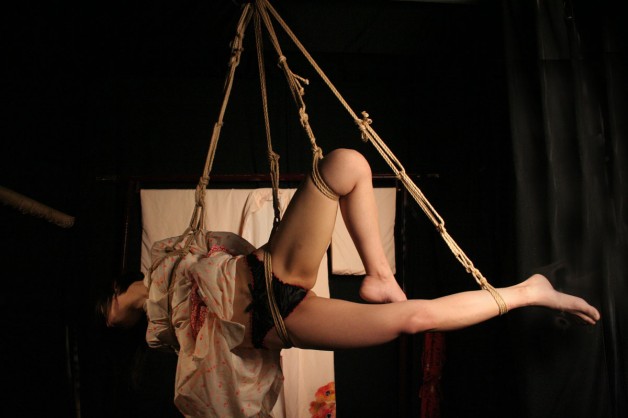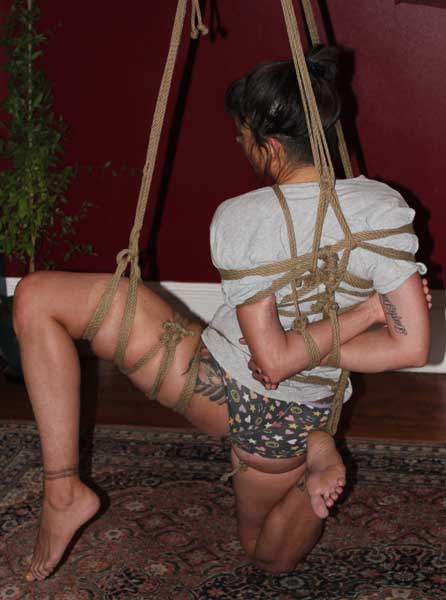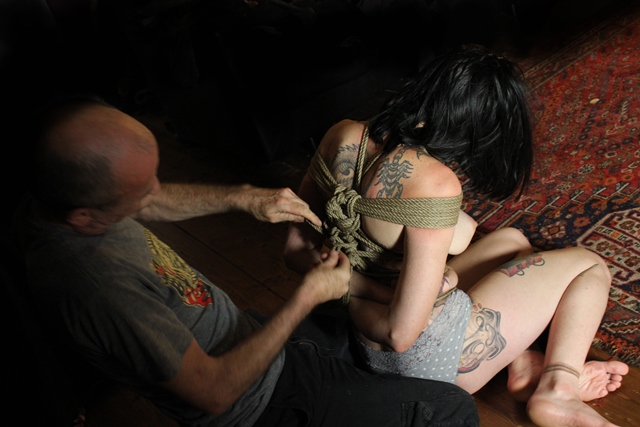The inverted ‘Y’ connection for hooking into the two wraps of the box-tie (takate-kote), taught by the likes of Osada Steve, seems to be used pretty much universally. I much prefer the version where the line is locked into a short bight thus avoiding ‘burning the bight’. This is a definite improvement over the way some just use the bight to lift, thus constantly sawing rope across the single strand of that loop. The bight is always the first bit of a rope to wear, so why accelerate this on a critical component? It’s asking for trouble. Suspension is risky without adding to the things that can go wrong and a main line failure is about as bad as it gets. However, how many of us have examined when it has advantages and disadvantages?
[private] Nina was trying out some moves last night with MaYa which involved a suspension where her torso was held upright with the main line linkage at rear. The problem we encountered was that almost all the tension was thus transferred to the lower wraps since the load was vertical and the lower arm of the ‘Y’ took most of the load. You can see what I mean in this photo where the lower wrap is being pulled into an ‘M’ shape. Granted, the effect would have been reduced if the ‘Y’ were to be shorter thus bringing the load into the centre and so minimising the distortion and transmitting more of the load up the stem. Of course, the longer the arms of the ‘Y’, the more there is a chance it will move and distrubute pressure more on one side than the other.Whilst MaYa, who’s a tough cookie anyway, felt OK with this, we thought it would be more desireable if the load was more equally distributed. Of course, one could go down the route that we have seen Kazami and Kinoko use where there is a 3-point connection, at the centre and on the wraps. However, this technique seems to be reserved for suspensions which are largely upright. So, what is the best way of distributing the load more evenly if you intend to go through transitions where the torso position changes (for the moment, we will only consider tie offs at the rear)? Nina felt that the old style kinbakushi have something to teach us here and I can’t fault the logic. With a central connection that brings every thing together with no slack, it would appear to give even tesnion on both wraps regardless of torso position. I can’t see a downside to this. I’d be interested to hear if anyone has any thoughts on why this is not more commonly used.
I can see that the inverted ‘Y’ connection has the advantage of keeping the wraps apart for sideways or face up suspension but beyond that I can see little benefit. In fact, given that in a sideways suspension the wraps on the arm uppermost are pulled away from it, it provides no obvious advantage except aesthetically in my opionion.
Most of the old-style suspensions appear to tie off tightly to the centre of the harness at the rear. It seems common that this friction ultimately includes both wraps and often ends up as quite a bulky ‘lump’ of rope. The picture below gives one of my interpretations of the sort of friction I mean. This would seem a very elegant solution since it ensures that the load is as equal as it can be on both wraps, regardless of the direction of the load, surely?
I don’t claim to know everything on this subject and my reasoning might well be flawed, so feel free to comment if you disagree or spot other issues that I might have missed.
[/private]


